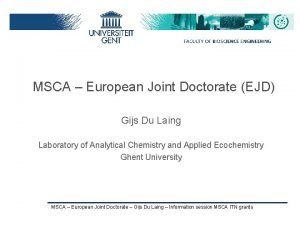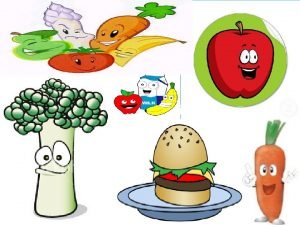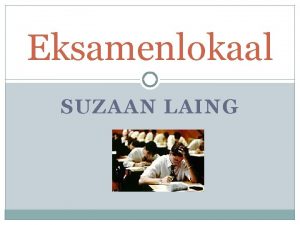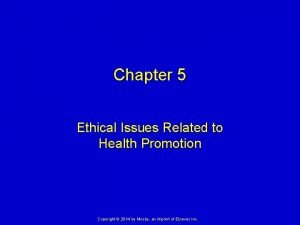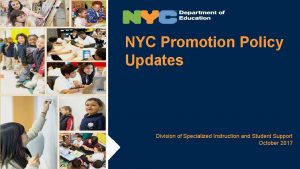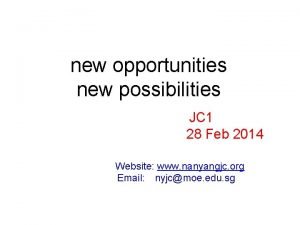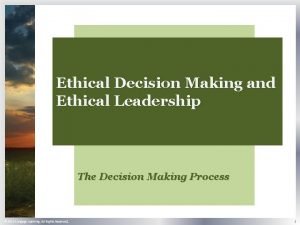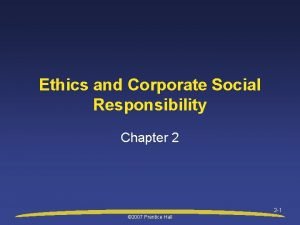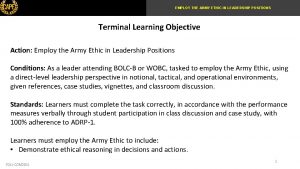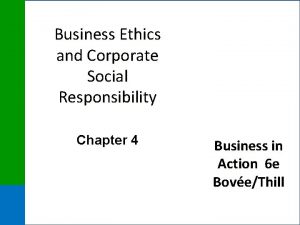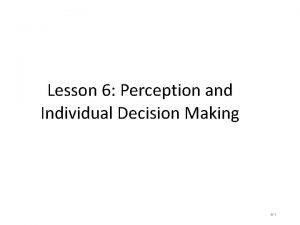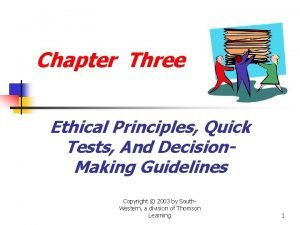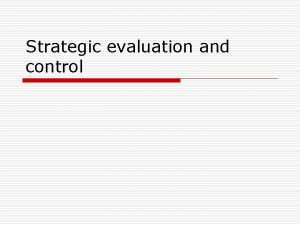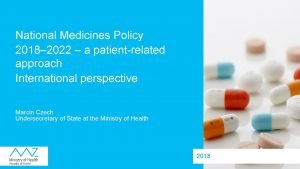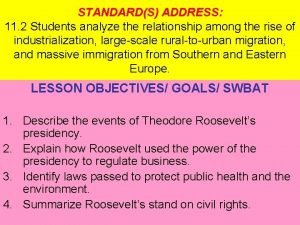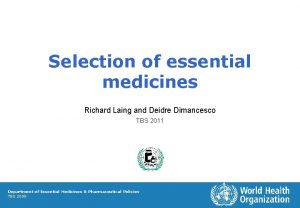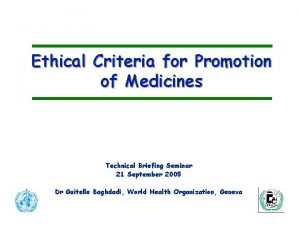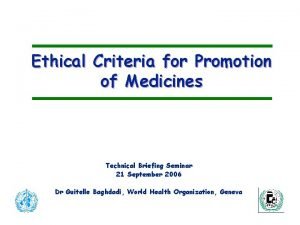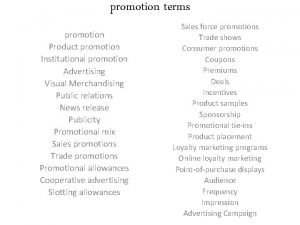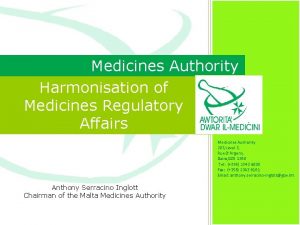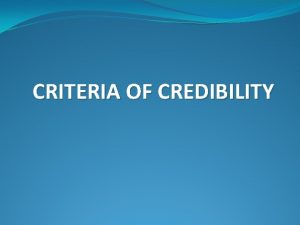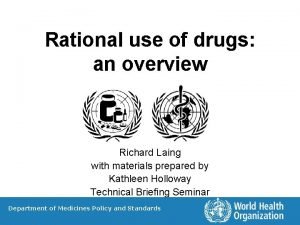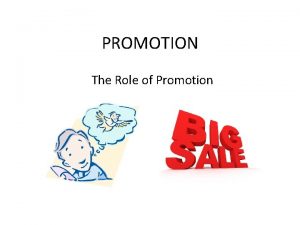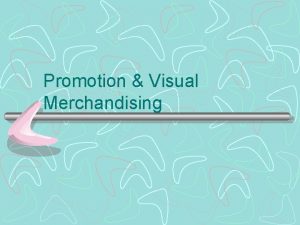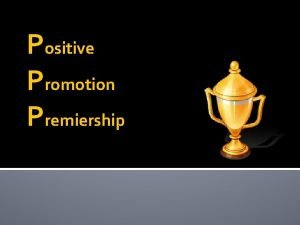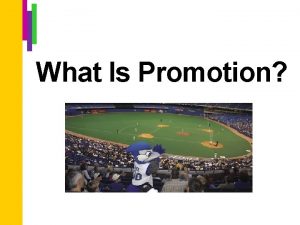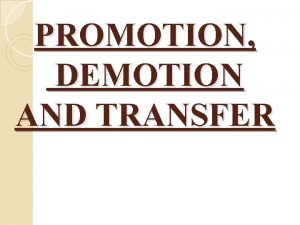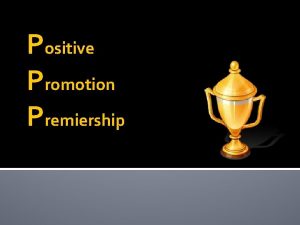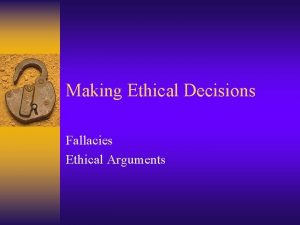Ethical Criteria for Promotion of Medicines Richard Laing

















- Slides: 17

Ethical Criteria for Promotion of Medicines Richard Laing with materials produced by Dr Guitelle Baghdadi, Technical Briefing Seminar World Health Organization, Geneva


WHO definition of promotion "All informational and persuasive activities by manufacturers and distributors, the effect of which is to induce the prescription, supply, purchase and/or use of medicinal drugs" 3

Examples of promotional tools and target audiences n Prescribers n n n n Pharmacies n n n Consumers Discounts Gifts Educational events Monitoring of prescriptions n n n 4 Sales Representatives Education events Journal advertisements Gifts Samples Enter patients in clinical trials against payment Physicians or opinion leaders paid as speakers Direct to consumer advertising (DTCA) Medicalisation or "illness promotion" Support to patient-help organizations

"Imbalance between commercially produced and independent drug information" (1) n Large amount of money spent around the world: ä US: US$ 13 – 15 billion (2000) (1) ä Australia: US$ 1. 3 – 2 billions per year (2) ä Italy: US$ 1. 1 billion (1998) (1) ä Low-income countries: 20 – 30% of sales revenue (1) n Growth spending on DTCA for prescription drugs ä US: n US$ 55 million (1991) to US $ 2. 4 billion (2001) (3) Others figures (US): ä currently 80, 000 sales reps (1) ä 314, 000 physician events in 2003 (sponsored industry) (1) ä free samples: $ 11 billion (retail value) or $ 2 -3 billion (prod. cost) n Only 50% countries have drug information centres (1999) (1) WHO Medicines Strategy 2004 – 2007 (2) www. healthyskepticism. org (3) HAI, DTCA prescription drugs, the European Commission's proposal for legislative change, December 2001 5 (1)

Increasing evidence that promotion techniques influence physicians' prescribing n Medical journals ad: informational content generally poor (1) ä Headlines can be misleading (32%) ä Lead to improper prescribing if no additional information (44%) ä Little or no educational value (57%) ä Often minimize risks and harmful effects (50% to 60%) n Advertisement material: only 6% material supported by scientific evidence (2) ä 15% of brochures did not contain any citations ä 22% citations listed could not be found ä 63% info correctly referenced but articles did not reflect results n Sponsored medical conferences ä Attendance associated with increased prescribing of sponsored product (3) (1) Wilkes M. Pharmaceutical Advertisements in Leading Medical journals: Experts' Assessment. Ann Intern Med. 1977; 87: 114 -5 (2) Tuffs A. Only 6% of drug advertising material is supported by evidence [news]. BMJ 2004; 328: 485 (3) Wazana A. Physicians and the pharmaceutical industry. JAMA 2000; 283: 373 -380 6

Sales representatives too often only source of information for health professionals n Interactions start during medical school (2) n 80 – 95% doctors see sales reps regularly (1) ä average 4 times a month (2) ä US: 1 sales rep for 15 to 30 physicians (3) n Seen as important source of info (new drugs) (3) n 10% sales reps statements are inaccurate (3) n 25% doctors recognize inaccurate statements (3) 7 (1) Moynihan R. Who pays for the pizza? BMJ 2003; 326: 1189 -1192 (2) Wazana A. Physicians and the pharmaceutical industry. JAMA 2000; 283: 373 -380 (3) Ziegler M. & al. . The accuracy of drug information from pharmaceutical sales representatives. JAMA 1995; 273: 1296 -1298

Gifts, trips, dinners influence prescribing habits & power needs to be acknowledged n Most doctors deny gifts influence their prescribing n Recognized as conflict of interest and established "ceilings" (e. g. $ 100 in US) (2) n Small gifts play important role (2) (1) ä Pens, note pads, etc. act as "reminder items" (2) ä Sole or among top reasons to see sales reps (1) n Psychological ä Food, aspects: indebtedness, reciprocity(2) flattery and friendships: powerful tools of persuasion (1) Wazana A. Physicians and the pharmaceutical industry. JAMA 2000; 283: 373 -380 (2) Katz D & al. All gifts large and small: toward an understanding of the ethics of pharmaceutical industry gift giving. AM J Bioethics. 2003; 3: 39 -46 8

DTCA of prescription-only medicines in legal in only US and New Zealand n US since 1980 s DTCA raises concerns, despite advocacy that ä FDA decision 1997: relax restrictions on radio and TV it creates better informed patients: ä 2003: n US$ 3 billion per year Increases prescription costs (2) ä 8. 5 m. people request & receive prescription after advertisement Misleading statements nn. New Zealand lead to irrational use and undue risks 1) ä 2003: GPs launched campaign for ban n Often breach regulation (2) ä 2005: Health Minister plans to ban it from 2005 (1) Strains on relation (2) nn. Rejected byphysicians-patient EU health ministers in June 2003 and EU inof December 2003 (3) nparliament No evidence health benefits n All n other countries (internet, satellite, Promotes medicalisation of normal life (2)etc. ) (1) Mansfield P. & al. Direct to consumer advertising is at crossroads of competing pressures from industry and health needs, BMJ 2005; 330: 5 -6 (2) HAI, DTCA prescription drugs, the European Commission's proposal for legislative change, December 2001 9 (3) Mansfield P. & al. DTCA is more profitable if it is misleading. NZ Med J 2003; 116 (1182)

Some DTCA examples

Promotional practices have multiple impact n Health impact irrational prescribing ä Example l l Rofecoxib (Vioxx) on market 1999 - 2003 80, 000 -139, 000 heart attacks and strokes in US (1) 27, 000 excess sudden cardiac death in US (2) n Economical impact increase in prescribing cost ä preference of new drugs ä decreased prescription of generics (3) n Image impact ä Trust in pharmaceutical industry ä Trust in medical profession (physicians, academia, etc. ) (1) Lenzer J. FDA is incapable of protecting US "against another Vioxx". BMJ 2004; 329 (News) (2) Horton R. Vioss, the implosion of Merck, and aftershocks at the FDA, Lancet 2004, 365: 1995 11 (3) Wazana A. Physicians and the pharmaceutical industry. JAMA 2000; 283: 373 -380

WHO ethical criteria (1988) still relevant today, more than ever n Reliable, accurate, truthful, information, balanced, up-to date, capable of substantiation and in good taste n NOT misleading or unverifiable or omissions n Scientific public data made available n No financial/material benefit offered to health professional n Scientific and educational activities not used for promotional purposes 12

WHO ethical criteria cover wide arrange of promotional activities n Advertising: ä Professionals: min. summary scientific information Although disseminated widely: ä Consumers: help make rational decisions n Medical representatives n not widely known ä technical knowledge and ethical conduct ä Complete/unbiased information and no offer inducement not implemented in nationalofdrug n Samples regulatory legislation ä Modest quantities for prescription drugs n ä Difficult to justify for non-prescription drugs not promoted in universities and scientific meetings professional associations ä Objective scientific content & independent scientists n n Symposia ä Sponsorship n clearly stated, gifts secondary to main purpose Post-marketing scientific studies ä Inform health authorities and validated relevant committees ä "… not misused as disguised form of promotion" 13

Examples of responses in countries include regulation, policy and training interventions n n n Increase awareness of physicians Independent drug information centres (professionals and consumers) Code of conduct (professional associations, pharmaceutical industry) Publicly funded continuing education of staff Training of medical students to critically assess pharmaceutical promotion ä successful impact (1) n experience in Indonesia with long-term Italian levy on marketing expenditure to be used for "public good research" (1) Drug advertisements: a critical lesson for Indonesian students, WHO, Essential Drugs Monitor, 1997, Issue n° 23, 23 14

Joint-venture with Health Action International http: //www. drugpromo. info/ 15

Examples of recent Publications to address Promotional Activities n Drug Promotion what we know, what we have yet to learn, Reviews of materials in the WHO/HAI database on drug promotion by Pauline Norris, Andrew Herxheimer, Joel Lexchin, Peter Mansfield WHO/EDM/PAR/2004. 3 n Educational initiatives for medical and pharmacy students about drug promotion (WHO/PSM/PAR/2005. 2) by Barbara Mintzes n Starting or Strengthening a Drug Bulletin, A Practical Manual (WHO/PSM/PAR/2005. 1) with ISDB 16

New Training Course to be Pilot tested in 2008 n Training course for pharmacists and medical students in how to respond responsibly to promotional activities n Materials based on content generated by survey and from experienced teachers n Will be subject to a randomized trial in 7+ English, Spanish, Russian schools of medicine or pharmacy in 2008 n Watch for the results!!! 17
 Gijs du laing
Gijs du laing Laing carbs
Laing carbs Eksamenlokaal suzaan laing
Eksamenlokaal suzaan laing Ethical issues in health promotion
Ethical issues in health promotion Insesis
Insesis Promotion criteria to sec 2
Promotion criteria to sec 2 Nus grading system
Nus grading system Ethical decision making and ethical leadership
Ethical decision making and ethical leadership Perbedaan ethical dilemma dan ethical lapse
Perbedaan ethical dilemma dan ethical lapse Army ethical lenses
Army ethical lenses Chapter 4 business ethics and social responsibility
Chapter 4 business ethics and social responsibility Contrast the three ethical decision criteria
Contrast the three ethical decision criteria Three ethical decision criteria
Three ethical decision criteria Power in looking for richard
Power in looking for richard Richard rumelt criteria for strategy audit
Richard rumelt criteria for strategy audit Medicines information centre
Medicines information centre National medicines policy
National medicines policy Summarize roosevelt's approach to environmental problems
Summarize roosevelt's approach to environmental problems
